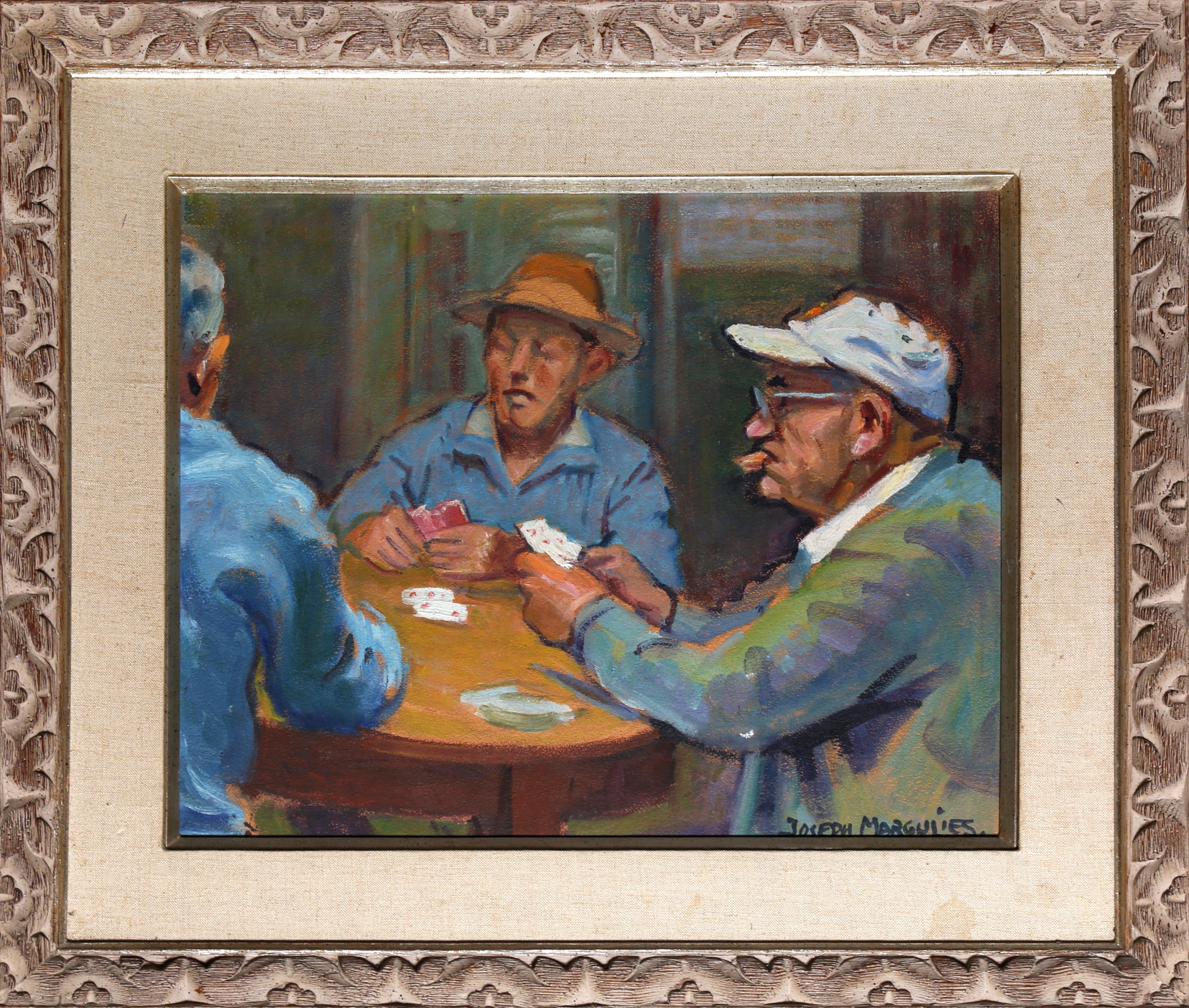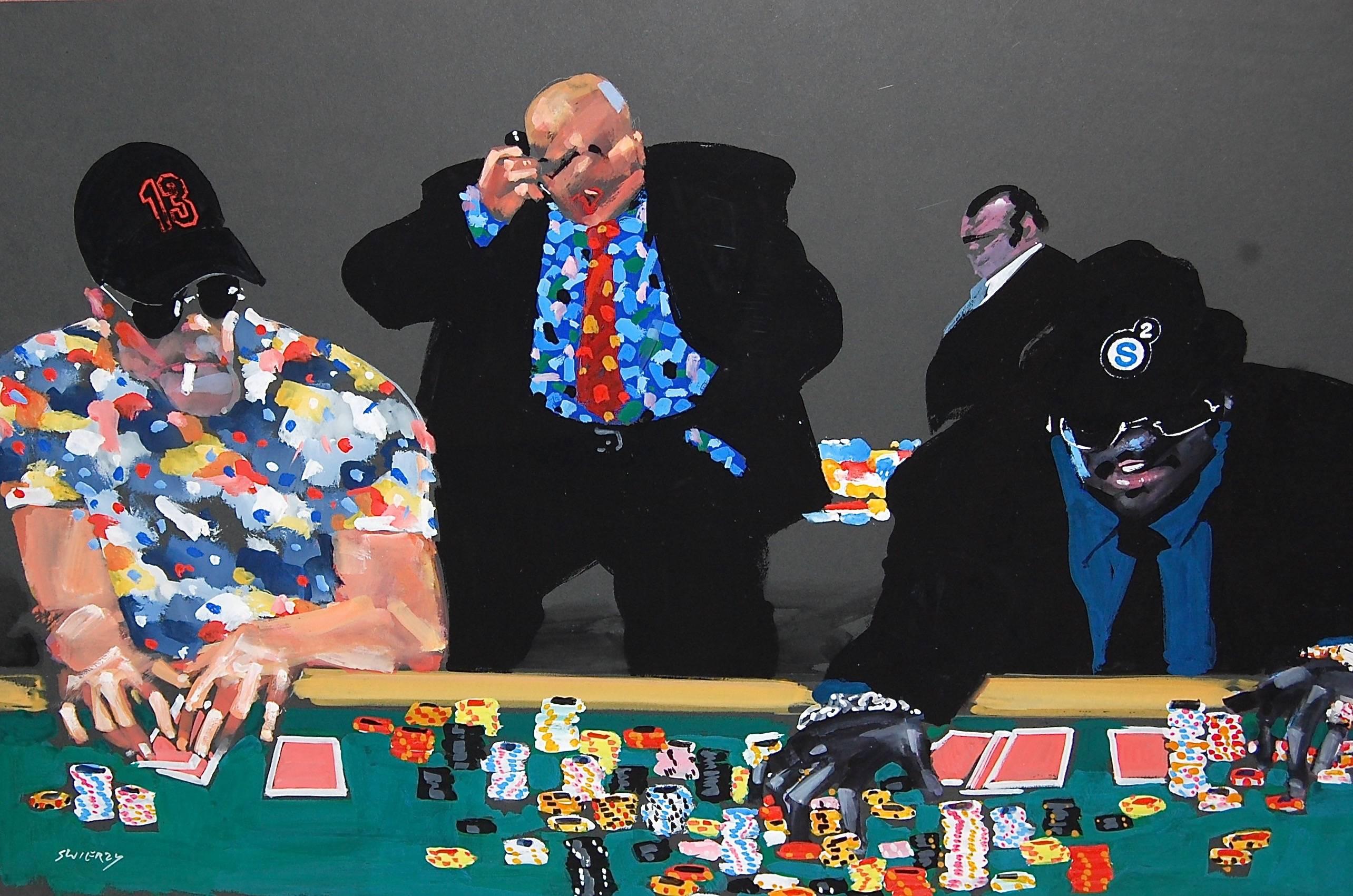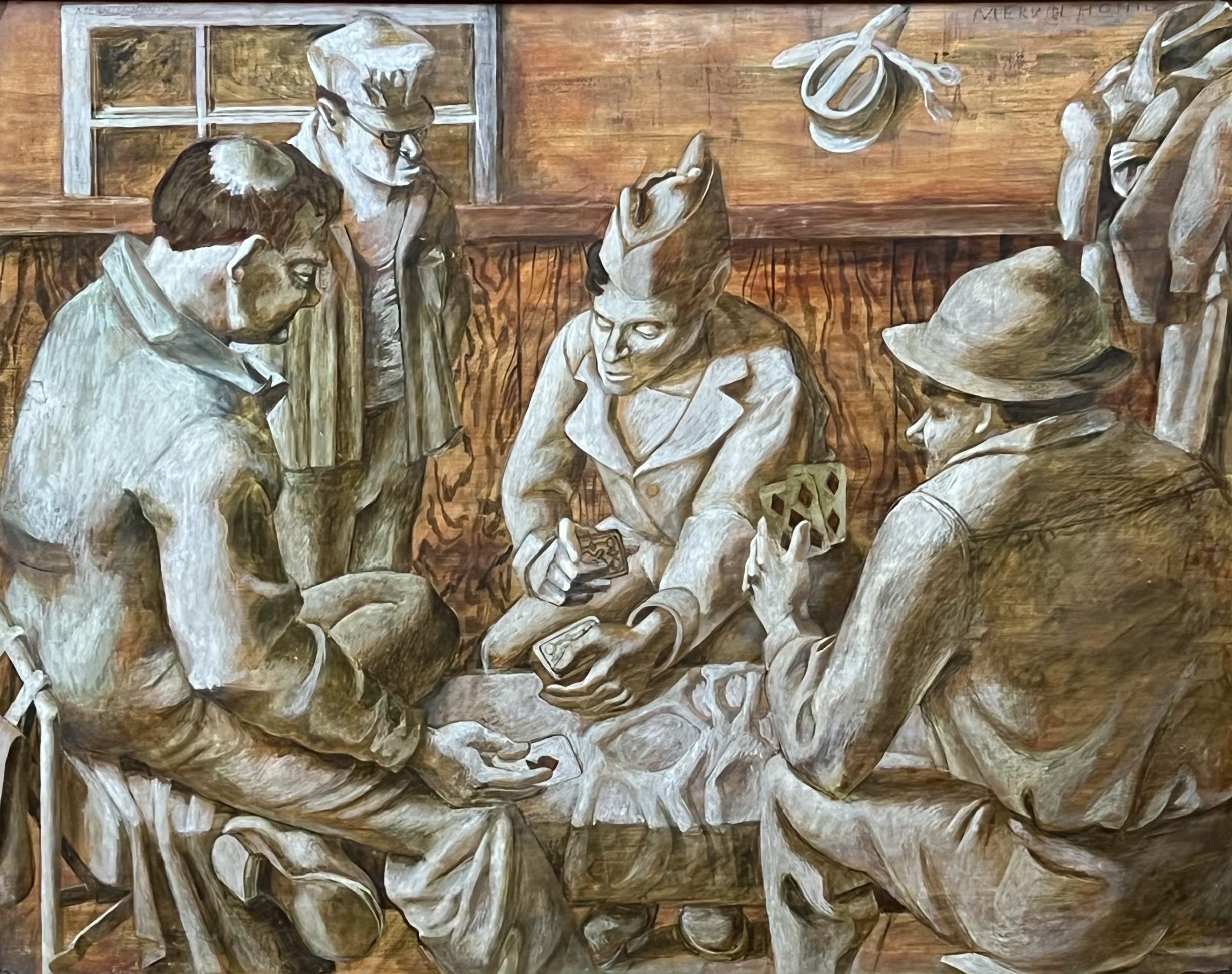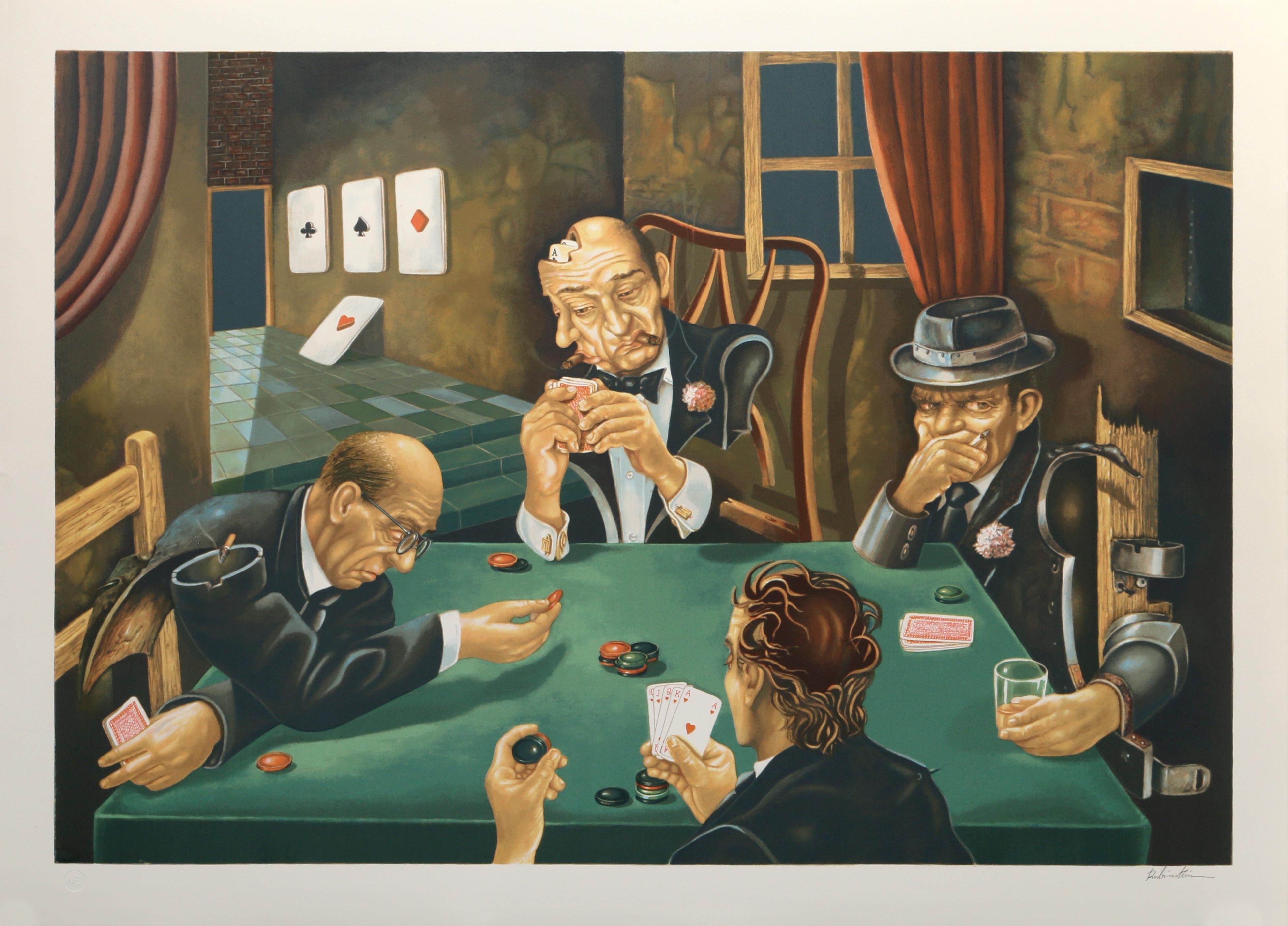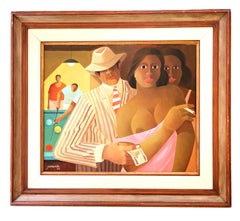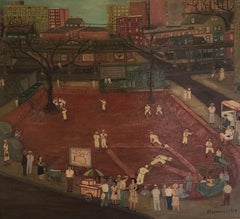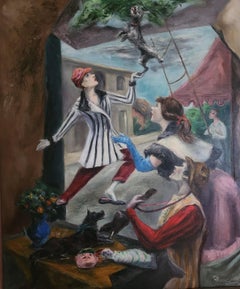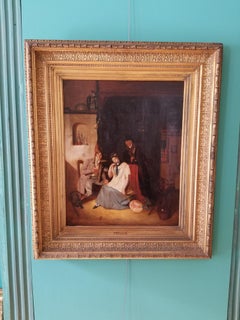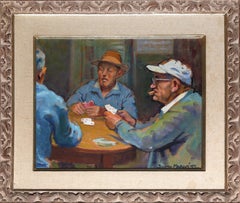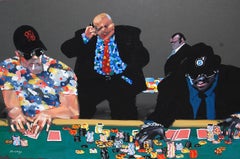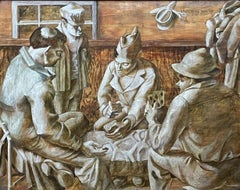Items Similar to Card Players, Playing Five Card Stud
Want more images or videos?
Request additional images or videos from the seller
1 of 11
Paul Valentine LantzCard Players, Playing Five Card Stud1938
1938
$35,000
£27,249.85
€30,990.92
CA$50,356.64
A$55,314.54
CHF 28,907.72
MX$659,671.74
NOK 366,049.95
SEK 341,006.40
DKK 231,578.76
About the Item
Signed lower right.
Description
A socio-political play on the smoky, masculine enclave scene of a card game, seven men from all walks of life appear in a dim room, the table bearing four players brightly lit from above. The players may be read as symbolic of the class system. Clockwise, the law man with his badge, the tattooed and unshaven blue collar worker, the brilliantine white collar or upper class, viewed by suspicion by the former two, and the poor man, in his ill fitting and unbuttoned plaid shirt. These additional figures provide further commentary and social critique: From left, the disinterested or dejected, his face hidden by his cap. the center figure, who alone looked at the viewer as if daring them to make a bet or judgement call, and the studios bookie at far right, meticulously taking bets and following the score.
Artist Biography
Paul Valentine Lantz (American, 1908-2000) worked in New Mexico, New York and Nebraska. He is best known for genre painting, illustrations and murals. He studied at the Kansas City Art Institute. He was then the youngest student enrolled. He also studied at The National Academy and Art Students League, and Europe. After the Second World War, and after completing his service, he lived in both upstate New York and Mexico.
About the Seller
4.2
Vetted Professional Seller
Every seller passes strict standards for authenticity and reliability
Established in 1992
1stDibs seller since 2015
32 sales on 1stDibs
Typical response time: 16 hours
- ShippingRetrieving quote...Shipping from: Saratoga Springs, NY
- Return Policy
More From This Seller
View AllPool Hall
By Jaimendes
Located in Saratoga Springs, NY
Signed lower left and dated 1984.
Presented here is a compelling work by the acclaimed Brazilian artist Jaimendes (b. 1939), titled "Pool Hall" (c. 1984), ...
Category
1980s Realist Figurative Paintings
Materials
Canvas, Oil
$5,000
Sand Lot Baseball
By Ralph Fasanella
Located in Saratoga Springs, NY
Signed lower right and dated 1954.
Bio:
FASANELLA, RALPH (1914-97) was a self-taught painter who created large, colorful and intricate paintings of working-class culture and American politics from 1945 until his death in 1997.
Fasanella had an artistic vision born of a working life. A child of Italian immigrants, he spent his youth delivering ice with his father and enduring the harsh regimen of a Catholic reform school. During the Great Depression, Fasanella worked in garment factories and as a truck driver.
From his mother—a literate, sensitive, and progressive woman, Fasanella acquired a social conscience. Through her influence he became active in antifascist and trade union causes. Fasanella's political beliefs were radicalized by the Depression. His antifascist zeal led him to volunteer for duty in the International Brigades fighting fascism in Spain, where he served in 1937-1938.
Upon his return to New York City Fasanella became an organizer for various unions, particularly the United Electrical, Radio, and Machine Workers of America, with whom he achieved some major organizing successes.
In 1945, disillusioned by the labor movement and plagued by a painful sensation in his fingers, Fasanella started to draw. He left organizing and began to paint full time. He painted obsessively, capturing the vibrant moods of the city and the tumult of American politics. For a brief time he received some critical notice for his work, and had shows of his work in galleries as well as union halls. Fasanella included in his paintings a profusion of brightly colored details, showed interiors and exteriors simultaneously, and combined past and future. He populated his paintings with likenesses of family and friends.
In 1950 Fasanella married Eva Lazorek, a schoolteacher who supported the couple through over two decades of artistic obscurity and blacklisting by the FBI. In the 1950s Fasanella retreated from political content in his works out of fear of reprisals. With the emergence of the New Left in the 1960s, however, his works became large, sharply focused political essays using images from the popular media. In 1972 Fasanella was featured in "New York" magazine and in an illustrated coffee-table book, "Fasanella's City". His large-scale, intricate paintings of urban life and American politics were then introduced to art critics and the public.
In the late 1970s Fasanella spent two years in Lawrence, researching the 1912 Bread and...
Category
1950s Other Art Style Figurative Paintings
Materials
Canvas, Oil
Price Upon Request
In the Moment
By Peggy Dodds
Located in Saratoga Springs, NY
Signed lower right.
Peggy Dodds Williams
1900-1987
She studied at the Collegiate University, Paterson, New Jersey, Art Students League in New York; studied under Kuniyoshi and H. ...
Category
Mid-20th Century Realist Figurative Paintings
Materials
Oil
$12,500
The Question to be Answered
Located in Saratoga Springs, NY
A beautiful 19th Century Northern European School genre, as a young gentleman poses a question to the young lady, as the father looks on. All is original and with the period frame. A...
Category
Late 19th Century Realist Interior Paintings
Materials
Canvas, Oil
Reminiscence
By Victor Khromin
Located in Saratoga Springs, NY
Signed lower right.
Provenance: Khromin Estate.
Victor Khromin, born in Gatchina City, near St. Petersburg, Russia explored his artistic abilities from the earliest years of his life. The Russian-Finish family into which Victor was born discovered and accepted his talent as something that flowed organically through their family tree. Victor's grandfather was an accomplished artist and a student of Repin at the Academy of Art in St. Petersburg, Russia.
The scenery of childhood in a small Finnish village on the outskirts of St. Petersburg continues to inspire Victor throughout his life.Victor went on to study art professionally at the Serov School of Fine Art in Leningrad. While still a student, he actively participated in non-conformist exhibitions, which were illegal during the Soviet Regime. In 1976, Victor became a member of the USSR Union of Professional Artists. This was the only Soviet organization, which could recognize an individual as a career artist. Despite membership, he continued to exhibit his works as part of the Underground Art Movement, which contradicted the code of conduct outlined by the USSR Union of Professional Artists and rejected the only officially accepted style of Socialist Realist. Victor's works stopped being presented for exhibition within official circles of the Soviet Art League. Victor became a target for government harassment and monitoring.
The 1985 solo exhibition at the Kudamm Gallery, in Berlin, served as a breaking point in the semi-tolerant relationship that had previously existed between Victor and the USSR Union of Professional Artists. According to the Union, an artist was not allowed to exhibit outside of the USSR without the permission of and censorship by that organization. That same year, Victor lost the position, which he had obtained through the Union. He relocated to a small village called Sinicheno, where over the course of 5 years, he created a series of lyrical pieces. The works were displayed at a solo exhibition at Dianart Gallery in Zurich in 1988, and at Arcole Auction, Paris in 1988-1990.The Perestroika finally opened doors for Victor to exhibit within Russia at "From Unofficial Art to Perestroika," in Leningrad in 1989 and The Stanislavski Actor's House in Leningrad in 1990.
In 1990, Victor received an invitation to come to New York City for a Solo exhibition at Nahamkin Gallery. During this trip, Victor applied for legal residency within the United States and was granted this status for his Extraordinary Abilities in Art. In 1996, Victor's paintings become part of the Norton and Nancy Dodge Collection of Nonconformist Art at Rutgers University. From this point on, Victor and his family move to rural upstate New York. Here he continues the development of unique techniques for creating 3D casts for oil paintings and paper. Victor's recent works are hand-made paper reliefs, with acrylic used as a color addition to the texture. He also developed a relining technic, which allow him to transfer his reliefs to canvas, and then work with oil paint over the underlying relief.
He has also been represented by Jane Voorhees Zimmerli Art Museum of The Norton & Nancy Dodge Collection of Nonconformist Art from the Soviet Union (1956-1986) at Rutgers University, New Brunswick, NJ; Dianart Gallery, Zurich, Switzerland; Kudam Gallery in Berlin, Germany; Codriorg Pallas Museum , Tallinn, Estonia; Urmala Exhibition Hall, Urmala, Latvia; Regional exhibition in Russia, and solo exhibitions in St. Petersburg, Russia, etc.
The specific style category...
Category
1990s Abstract Abstract Paintings
Materials
Marble
Moscow Speaking
By Valery Karacev
Located in Saratoga Springs, NY
Signed in Cyrillic, verso
Category
1980s Modern Figurative Paintings
Materials
Oil
You May Also Like
Men Playing Cards, Painting by Joseph Margulies
By Joseph Margulies
Located in Long Island City, NY
An original Gouache painting measuring 16 x 20 inches by Joseph Margulies. The painting is signed lower right. Born in Vienna, Joseph Margulies becam...
Category
1960s American Impressionist Figurative Paintings
Materials
Board, Gouache
The Card Players
By Waldemar Swierzy
Located in Lake Worth Beach, FL
The Card Players Size: 32"x20" framed 48"x36"
Waldemar Swierzy (1931 -2013) was born in Katowice Poland. A graduate of the Cracow Academy of Fine Ar...
Category
1990s Modern Figurative Paintings
Materials
Illustration Board, Acrylic
Army Poker
Located in Los Angeles, CA
This work is part of our exhibition - America Coast to Coast: Artists of the 1940s
Army Poker, c. 1943, probably tempera on board, signed upper right, 16 x 20 inches, inscribed verso a) “Army Poker / Mervin Honig / 421 W 42 St. N.Y.C.,” b) “Mervin Honig / US Army Air Force – Seymour Johnson Field – Goldsboro, NC / Circa 1943,” and c) “(This painting was done before men was (sic) shipped off to the Mariana Islands (Saipan) The Second World War.” Note: four pencil sketches for this work included
Mervin Honig was a New York-based painter and illustrator who is best known for his realistic depictions of everyday life and sports themes. Honig was raised in Brooklyn and recalled almost never being without a paintbox in hand from the time he started elementary school. Honig had a deep reverence for the Old Master painters, Vermeer and Bellini, as well as the Americans Winslow Homer and Thomas Eakins. He initially studied art from 1939 through 1941 with Francis Criss. At the outbreak of World War II, Honig worked as a mechanic for Republic Aviation, but in August 1942, he enlisted in the US Army Air Corps and was stationed at Seymour Johnson Field in Goldsboro, North Carolina. During the war, Honig began to exhibit nationally, including as part of the Portrait of America exhibitions which originated at the Metropolitan Museum of Art and traveled around the country, as well as at the Carnegie Institute in Pittsburgh. He painted Army Poker in 1943 while stationed at Johnson Field. In this work, Honig draws inspiration from Paul Cezanne's The Card Players (Metropolitan Museum of Art), with a similar placement of the four figures, but Cezanne's table is replaced with an Army cot, the pipe rack with a soldier's mess kit and the drapery in the right background with a heap of discarded uniforms. Unlike the vibrancy of Cezanne's composition, the limited palette of Honig's work suggests the drabness and monotony of stateside Army life.
After being discharged from military service, Honig furthered his studies with Amadee Ozenfant in 1946 and Hans Hoffman from 1947 through 1950. Additional exhibitions included the Whitney Museum of American Art, the Brooklyn Museum, the Los Angeles County Museum of Art, the National Academy of Design, the Wadsworth Atheneum, the Provincetown Art Association, and the National Academies Galleries of the Allied Artists Association. He was represented by the venerable Frank Rehn...
Category
1940s American Realist Paintings
Materials
Oil, Board, Tempera
Card Players, Folk Art Oil Painting on Canvas by Harry Gottlieb
By Harry Gottlieb
Located in Long Island City, NY
Artist: Harry Gottlieb, Romanian/American (1895 - 1992)
Title: Card Players
Year: circa 1960
Medium: Oil on Canvas, signed l.l.
Size: 20 x 24 inches
Frame Size: 28 x 32 inches
Category
1960s Impressionist Figurative Paintings
Materials
Canvas, Oil
$6,800 Sale Price
20% Off
The Poker Game, Surrealist Screenprint by Israel Rubinstein
Located in Long Island City, NY
The Poker Game by Israel Rubinstein, Israeli (1944)
Date: 1980
Screenprint, signed and numbered in pencil
Edition of 250
Image Size: 27 x 38 inches
S...
Category
1980s Surrealist Figurative Prints
Materials
Screen
English School Mid 20th Century Figurative Oil Painting "The Card Players"
Located in Cirencester, GB
ARTIST: Unsigned Mid 20th Century English School
TITLE: "The Card Players"
MEDIUM: oil on board
SIZE: 59cm x 23cm incl frame
CONDITION: very good
NOTES: A very interesting unusually...
Category
Mid-20th Century Post-Impressionist Figurative Paintings
Materials
Oil
More Ways To Browse
Rest On The Flight Into Egypt
Reut Harel
Robert Wright
Russian Girl
Ruth Opper
San Luis Potosi
Sarah Jane
Seville Oil Painting
Sir Lawrence Alma Tadema
The Card Players
Vintage Christmas Illustrations
Zack Zdrale
1600 Oil Paint
19th Century Painting Girl With Dog
50 X 60 Painting
A J Milne
Antonio Mancini
Batman Painting
